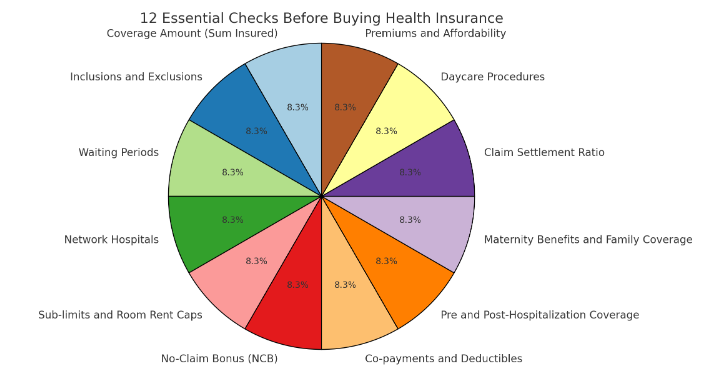When it comes to financial planning, health insurance is one of the most critical components, especially for those aiming for financial independence and early retirement (FIRE). Unexpected medical expenses can derail even the most solid financial plans. With the myriad of health insurance options available today, it’s crucial to choose the right policy that meets your needs without burning a hole in your pocket.
Here’s a checklist of key things to consider before buying health insurance:
1. Coverage Amount (Sum Insured)
One of the most important aspects to evaluate is the coverage amount. You want a policy that covers major medical emergencies without leaving you with massive out-of-pocket costs. Consider your lifestyle, city of residence, family history of illnesses, and rising medical costs when choosing the sum insured. For those on the FIRE journey, it’s better to opt for a slightly higher sum insured to ensure you’re fully protected in case of a significant medical event.
2. Inclusions and Exclusions
Every health insurance policy comes with a list of treatments, conditions, and medical services that are covered and not covered. Understanding the inclusions and exclusions can help you avoid unpleasant surprises during claims. For example, pre-existing diseases may not be covered immediately after buying a policy and could have a waiting period of up to 2-4 years.
3. Waiting Periods
Most health insurance policies have waiting periods for specific treatments such as maternity benefits, pre-existing conditions, or even certain surgeries. It’s essential to check these waiting periods, especially if you or your family members have known medical conditions that may require early treatment.
4. Network Hospitals
Ensure that the insurer has a wide network of hospitals, especially in your city or wherever you travel often. Cashless hospitalization is a huge benefit that comes with these network hospitals, sparing you the hassle of paying upfront and filing for reimbursement later. Before buying a policy, check the list of network hospitals and make sure they include reputable options in your area.
5. Sub-limits and Room Rent Caps
Some policies come with sub-limits on specific treatments or room rent caps, which means they’ll only cover up to a certain amount. For instance, if your policy has a room rent limit of ₹5,000 per day and you choose a room that costs ₹7,000 per day, you may end up paying the difference out of pocket. It’s better to opt for policies that either don’t have sub-limits or offer flexibility in room rent.
6. No-Claim Bonus (NCB)
If you don’t make any claims during the policy year, many insurers offer a No-Claim Bonus. This could either increase your sum insured or offer a premium discount on renewal. For long-term financial planning, especially in the FIRE community, it’s a good idea to look for policies with NCB benefits, as they reward healthy living and prudent use of insurance.
7. Co-payments and Deductibles
Some policies require the insured to bear a portion of the costs through co-payments or deductibles. While this may reduce your premium, it also increases out-of-pocket expenses when you file a claim. It’s important to strike the right balance between premiums and co-payment options that work for your financial plan.
8. Pre and Post-Hospitalization Coverage
Health insurance isn’t just about covering the hospital bill. You should also check if the policy covers pre and post-hospitalization expenses such as diagnostic tests, consultations, and follow-up treatments. Many policies cover expenses 30-60 days before hospitalization and up to 90 days after.
9. Maternity Benefits and Family Coverage
If you’re planning to start or expand your family, check if the policy offers maternity benefits. Many health insurance plans provide this, but they often come with long waiting periods. Additionally, if you’re opting for family floater plans, make sure the coverage is sufficient for all family members.
10. Claim Settlement Ratio
The claim settlement ratio is the percentage of claims an insurer has successfully paid out in comparison to the number of claims received. A higher ratio indicates the insurer is reliable when it comes to processing and settling claims. Check the insurer’s claim settlement ratio, and aim for companies with a ratio above 90%.
11. Daycare Procedures
Medical advancements have made many treatments possible without the need for a 24-hour hospital stay. Ensure that your policy covers such daycare procedures, as they are becoming increasingly common.
12. Premiums and Affordability
While it’s tempting to go for the most comprehensive policy available, premiums should fit within your budget without hampering your savings goals. Compare different plans based on their features and premiums, and choose one that provides the best value without stretching your finances too thin.
Conclusion
Health insurance is not just a purchase—it’s an investment in your future. For those on the path to early retirement, it plays a critical role in safeguarding your savings and ensuring that unexpected medical costs don’t delay your financial goals. Use this checklist as a guide to finding the best policy for you and your family, and always compare different plans before making your final decision.
Staying healthy is a big part of financial independence, but having the right safety net in place is just as important. Happy planning!
